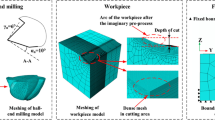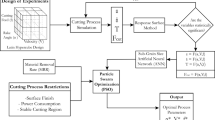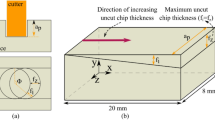Abstract
Aluminum 7075-T6 alloy has been widely employed in aviation, transport, and automobile applications due to its remarkable properties, while a lot of residual stresses can be generated in the machined surface and subsurface during the machining process. The machining parameters have significant effects on the formation of residual stress, it is important to predict the residual stress distribution with the cutting parameters and optimize the machining parameters to acquire the desirable residual profiles. Although many efforts of current studies have been paid to the prediction of residual stress profiles in different materials and machining processes, however, few works focused on residual stress in-depth profiles in the machining of 7075-T6 aluminum alloy, and the optimization of cutting parameters for required residual stress profile has also rarely been reported. Therefore, this study proposed an integrated prediction model, which combines exponential decay cosine function (EDC), particle swarm optimization (PSO), and back propagation neural network (BP), to predict the in-depth residual stress profile of the machined surface in milling of 7075-T6 aluminum alloy. Furthermore, according to the residual stress profile, the key features for describing the residual stress profile include the surface residual stress (SRS), maximum compressive residual stress (MCRS), depth of maximum compressive residual stress (DMCS), and depth of residual stress (DRS), were identified and analyzed. And a multiple objective optimization was conducted, where Kriging-based models were employed to establish the relationships between machining parameters and objectives (SRS and MCRS), and the MRR was also employed as an objective taking account of high production efficiency requirement. Finally, a two-stage optimization strategy integrating NSGA-III, MOPSO, and TOPSIS algorithms was used to address the multi-objective optimization model to obtain the expected residual stress profile and MRR. This work can provide some practical guidance for industrial production in machining 7075-T6 aluminum alloy.




















Similar content being viewed by others
References
Dursun T, Soutis C (2014) Recent developments in advanced aircraft aluminium alloys. Mater Des:56. https://doi.org/10.1016/j.matdes.2013.12.002
Singh AK, Singhal D, Kumar R (2019) Machining of aluminum 7075 alloy using EDM process: an ANN validation. Mater Today Proc 26. https://doi.org/10.1016/j.matpr.2020.02.591
Zhu B, Wang Y, Dluhoš J, London AJ, Gorley M, Whiting MJ (2022) A novel pathway for multiscale high-resolution time-resolved residual stress evaluation of laser-welded Eurofer97. Sci Adv:8. https://doi.org/10.1126/sciadv.abl4592
Liang X, Liu Z, Wang B, Wang C, Cheung C (2023) Friction behaviors in the metal cutting process: state of the art and future perspectives. Int J Extrem Manuf 5:012002
Singh A, Agrawal A (2015) Investigation of surface residual stress distribution in deformation machining process for aluminum alloy. J Mater Process Technol:225. https://doi.org/10.1016/j.jmatprotec.2015.05.025
El-Axir MH (2002) A method of modeling residual stress distribution in turning for different materials. Int J Mach Tools Manuf:42. https://doi.org/10.1016/S0890-6955(02)00031-7
Chen W, Voisin T, Zhang Y, Florien JB, Spadaccini CM, McDowell DL et al (2019) Microscale residual stresses in additively manufactured stainless steel. Nat Commun:10. https://doi.org/10.1038/s41467-019-12265-8
Sun C, Xiu S, Hong Y, Kong xiangna, Lu Y. (2020) Prediction on residual stress with mechanical-thermal and transformation coupled in DGH. Int J Mech Sci:179. https://doi.org/10.1016/j.ijmecsci.2020.105629
Schajer GS (1988) Measurement of non-uniform residual stresses using the hole- drilling method. Part I-stress calculation procedures. J Eng Mater Technol Trans ASME:110. https://doi.org/10.1115/1.3226059
Pagliaro P, Prime MB, Swenson H, Zuccarello B (2010) Measuring multiple residual-stress components using the contour method and multiple cuts. Exp Mech:50. https://doi.org/10.1007/s11340-009-9280-3
Wu J, Liu H, Wei P, Lin Q, Zhou S (2020) Effect of shot peening coverage on residual stress and surface roughness of 18CrNiMo7-6 steel. Int J Mech Sci:183. https://doi.org/10.1016/j.ijmecsci.2020.105785
Withers PJ, Turski M, Edwards L, Bouchard PJ, Buttle DJ (2008) Recent advances in residual stress measurement. Int J Press Vessel Pip:85. https://doi.org/10.1016/j.ijpvp.2007.10.007
Guo J, Fu H, Pan B, Kang R (2021) Recent progress of residual stress measurement methods: a review. Chinese J Aeronaut:34. https://doi.org/10.1016/j.cja.2019.10.010
Olson MD, DeWald AT, Prime MB, Hill MR (2015) Estimation of uncertainty for contour method residual stress measurements. Exp Mech:55. https://doi.org/10.1007/s11340-014-9971-2
Huang X, Liu Z, Xie H (2013) Recent progress in residual stress measurement techniques. Acta Mech Solida Sin:26. https://doi.org/10.1016/S0894-9166(14)60002-1
Ulutan D, Arisoy YM, Özel T, Mears L (2014) Empirical modeling of residual stress profile in machining nickel-based superalloys using the sinusoidal decay function. Procedia CIRP 13. https://doi.org/10.1016/j.procir.2014.04.062
Zhang C, Wang L, Meng W, Zu X, Zhang Z (2020) A novel analytical modeling for prediction of residual stress induced by thermal-mechanical load during orthogonal machining. Int J Adv Manuf Technol:109. https://doi.org/10.1007/s00170-020-05594-2
Shan C, Zhang M, Zhang S, Dang J (2020) Prediction of machining-induced residual stress in orthogonal cutting of Ti6Al4V. Int J Adv Manuf Technol:107. https://doi.org/10.1007/s00170-020-05181-5
Zhang W, Wang X, Hu Y, Wang S (2018) Predictive modelling of microstructure changes, micro-hardness and residual stress in machining of 304 austenitic stainless steel. Int J Mach Tools Manuf:130–131. https://doi.org/10.1016/j.ijmachtools.2018.03.008
Liang X, Liu Z, Wang B, Song Q, Cai Y, Wan Y (2021) Prediction of residual stress with multi-physics model for orthogonal cutting Ti-6Al-4V under various tool wear morphologies. J Mater Process Technol:288. https://doi.org/10.1016/j.jmatprotec.2020.116908
Wang SQ, Li JG, He CL, Laghari RA (2019) An analytical model of residual stress in orthogonal cutting based on the radial return method. J Mater Process Technol:273. https://doi.org/10.1016/j.jmatprotec.2019.05.015
Wan M, Ye XY, Yang Y, Zhang WH (2017) Theoretical prediction of machining-induced residual stresses in three-dimensional oblique milling processes. Int J Mech Sci:133. https://doi.org/10.1016/j.ijmecsci.2017.09.005
D’Oliveira ALR, Rego RR, de Faria AR (2020) Residual stresses prediction in machining: hybrid FEM enhanced by assessment of plastic flow. J Mater Process Technol:275. https://doi.org/10.1016/j.jmatprotec.2019.116332
Liu Y, Xu D, Agmell M, Ahadi A, Stahl JE, Zhou J (2021) Investigation on residual stress evolution in nickel-based alloy affected by multiple cutting operations. J Manuf Process:68. https://doi.org/10.1016/j.jmapro.2021.06.015
Ullah I, Zhang S, Waqar S (2022) Numerical and experimental investigation on thermo-mechanically induced residual stress in high-speed milling of Ti-6Al-4V alloy. J Manuf Process:76. https://doi.org/10.1016/j.jmapro.2022.02.039
Vovk A, Sölter J, Karpuschewski B (2020) Finite element simulations of the material loads and residual stresses in milling utilizing the CEL method. Procedia CIRP 87. https://doi.org/10.1016/j.procir.2020.03.005
Salloomi KN, Al-Sumaidae S (2021) Coupled Eulerian–Lagrangian prediction of thermal and residual stress environments in dissimilar friction stir welding of aluminum alloys. J Adv Join Process:3. https://doi.org/10.1016/j.jajp.2021.100052
Zhuang K, Zhou S, Zou L, Lin L, Liu Y, Weng J (2022) Numerical investigation of sequential cuts residual stress considering tool edge radius in machining of AISI 304 stainless steel. Simul Model Pract Theory:118. https://doi.org/10.1016/j.simpat.2022.102525
Yang D, Liu Z, Ren X, Zhuang P (2016) Hybrid modeling with finite element and statistical methods for residual stress prediction in peripheral milling of titanium alloy Ti-6Al-4V. Int J Mech Sci:108–109. https://doi.org/10.1016/j.ijmecsci.2016.01.027
Robles A, Aurrekoetxea M, Plaza S, Llanos I, Zelaieta O (2022) Empirical modeling of residual stress profiles in Ti6Al4V after face-milling. Procedia CIRP 108. https://doi.org/10.1016/j.procir.2022.03.059
Wang J, Zhang D, Wu B, Luo M (2017) Numerical and empirical modelling of machining-induced residual stresses in ball end milling of Inconel 718. Procedia CIRP 58. https://doi.org/10.1016/j.procir.2017.03.177
Wan M, Ye XY, Wen DY, Zhang WH (2019) Modeling of machining-induced residual stresses. J Mater Sci:54. https://doi.org/10.1007/s10853-018-2808-0
Ulutan D, Ozel T (2011) Machining induced surface integrity in titanium and nickel alloys: a review. Int J Mach Tools Manuf:51. https://doi.org/10.1016/j.ijmachtools.2010.11.003
Ulutan D (2013) Predictive modeling and multi-objective optimization of machining-induced residual stresses: investigation of machining parameter effects. Pro Quest Diss Theses
Elsheikh AH, Muthuramalingam T, Shanmugan S, Mahmoud Ibrahim AM, Ramesh B, Khoshaim AB et al (2021) Fine-tuned artificial intelligence model using pigeon optimizer for prediction of residual stresses during turning of Inconel 718. J Mater Res Technol:15. https://doi.org/10.1016/j.jmrt.2021.09.119
Khoshaim AB, Elsheikh AH, Moustafa EB, Basha M, Mosleh AO (2021) Prediction of residual stresses in turning of pure iron using artificial intelligence-based methods. J Mater Res Technol:11. https://doi.org/10.1016/j.jmrt.2021.02.042
Wang B, Liu Z, Cai Y, Luo X, Ma H, Song Q et al (2021) Advancements in material removal mechanism and surface integrity of high speed metal cutting: a review. Int J Mach Tools Manuf:166. https://doi.org/10.1016/j.ijmachtools.2021.103744
Zhao J, Dong Y, Ye C (2021) Optimization of residual stresses generated by ultrasonic nanocrystalline surface modification through analytical modeling and data-driven prediction. Int J Mech Sci:197. https://doi.org/10.1016/j.ijmecsci.2021.106307
Aggarwal A, Singh H, Kumar P, Singh M (2008) Optimizing power consumption for CNC turned parts using response surface methodology and Taguchi’s technique-a comparative analysis. J Mater Process Technol:200. https://doi.org/10.1016/j.jmatprotec.2007.09.041
Basheer AC, Dabade UA, Joshi SS, Bhanuprasad VV, Gadre VM (2008) Modeling of surface roughness in precision machining of metal matrix composites using ANN. J Mater Process Technol:197. https://doi.org/10.1016/j.jmatprotec.2007.04.121
Mathew J, Griffin J, Alamaniotis M, Kanarachos S, Fitzpatrick ME (2018) Prediction of welding residual stresses using machine learning: comparison between neural networks and neuro-fuzzy systems. Appl Soft Comput J:70. https://doi.org/10.1016/j.asoc.2018.05.017
Podstawczyk D, Witek-Krowiak A, Dawiec A, Bhatnagar A (2015) Biosorption of copper(II) ions by flax meal: empirical modeling and process optimization by response surface methodology (RSM) and artificial neural network (ANN) simulation. Ecol Eng:83. https://doi.org/10.1016/j.ecoleng.2015.07.004
Cheng M, Jiao L, Yan P, Feng L, Qiu T, Wang X (2021) Prediction of surface residual stress in end milling with Gaussian process regression. Meas J Int Meas Confed:178. https://doi.org/10.1016/j.measurement.2021.109333
Nguyen TT (2019) Prediction and optimization of machining energy, surface roughness, and production rate in SKD61 milling. Meas J Int Meas Confed:136. https://doi.org/10.1016/j.measurement.2019.01.009
Li Y, Xiong M, He Y, Xiong J, Tian X, Mativenga P (2022) Multi-objective optimization of laser welding process parameters: the trade-offs between energy consumption and welding quality. Opt Laser Technol:149. https://doi.org/10.1016/j.optlastec.2022.107861
Liu B, Jin W, Lu A, Liu K, Wang C, Mi G (2020) Optimal design for dual laser beam butt welding process parameter using artificial neural networks and genetic algorithm for SUS316L austenitic stainless steel. Opt Laser Technol:125. https://doi.org/10.1016/j.optlastec.2019.106027
Gao Y, Liu Q, Wang Y, Zhao W (2017) Lightweight design with weld fatigue constraints for a three-axle bogie frame using sequential approximation optimisation method. Int J Veh Des:73. https://doi.org/10.1504/IJVD.2017.082577
Prevéy PS (1996) Current applications of X-ray diffraction residual stress measurement. Dev Mater Characterization Technol, pp 103–110
Gu C, Lian J, Bao Y, Xie Q, Münstermann S (2019) Microstructure-based fatigue modelling with residual stresses: prediction of the fatigue life for various inclusion sizes. Int J Fatigue:129. https://doi.org/10.1016/j.ijfatigue.2019.06.018
Yan J, Li L (2013) Multi-objective optimization of milling parameters-the trade-offs between energy, production rate and cutting quality. J Clean Prod:52. https://doi.org/10.1016/j.jclepro.2013.02.030
Rai R, Tiwari MK, Ivanov D, Dolgui A (2021) Machine learning in manufacturing and industry 4.0 applications. Int J Prod Res:59. https://doi.org/10.1080/00207543.2021.1956675
Sathish T (2019) Experimental investigation of machined hole and optimization of machining parameters using electrochemical machining. J Mater Res Technol:8. https://doi.org/10.1016/j.jmrt.2019.07.046
Pimenov DY, Abbas AT, Gupta MK, Erdakov IN, Soliman MS, El Rayes MM (2020) Investigations of surface quality and energy consumption associated with costs and material removal rate during face milling of AISI 1045 steel. Int J Adv Manuf Technol:107. https://doi.org/10.1007/s00170-020-05236-7
Zhou Y, Cao S, Kosonen R, Hamdy M (2020) Multi-objective optimisation of an interactive buildings-vehicles energy sharing network with high energy flexibility using the Pareto archive NSGA-II algorithm. Energy Convers Manag:218. https://doi.org/10.1016/j.enconman.2020.113017
Premkumar M, Jangir P, Sowmya R, Alhelou HH, Heidari AA, Chen H (2021) MOSMA: multi-objective slime mould algorithm based on elitist non-dominated sorting. IEEE. Access:9. https://doi.org/10.1109/ACCESS.2020.3047936
Al-Amin M, Abdul-Rani AM, Ahmed R, Shahid MU, Zohura FT, Rani MDBA (2021) Multi-objective optimization of process variables for MWCNT-added electro-discharge machining of 316L steel. Int J Adv Manuf Technol:115. https://doi.org/10.1007/s00170-021-07169-1
Deb K, Agrawal S, Pratap A, Meyarivan T (2000) A fast elitist non-dominated sorting genetic algorithm for multi-objective optimization: NSGA-II. Lect Notes Comput Sci (Including Subser Lect Notes Artif Intell Lect Notes Bioinformatics):1917. https://doi.org/10.1007/3-540-45356-3_83
Deb K, Jain H (2014) An evolutionary many-objective optimization algorithm using reference-point-based nondominated sorting approach, part I: solving problems with box constraints. IEEE Trans Evol Comput:18. https://doi.org/10.1109/TEVC.2013.2281535
Coello Coello CA, Pulido GT, Lechuga MS (2004) Handling multiple objectives with particle swarm optimization. IEEE Trans Evol Comput:8. https://doi.org/10.1109/TEVC.2004.826067
Li Y, Zhang S, Zhang J, Yin Y, Xiao W, Zhang Z (2020) Data-driven multiobjective optimization for burden surface in blast furnace with feedback compensation. IEEE Trans Ind Inf 16. https://doi.org/10.1109/TII.2019.2908989
Akhtar W, Lazoglu I, Liang SY (2022) Prediction and control of residual stress-based distortions in the machining of aerospace parts: a review. J Manuf Process:76. https://doi.org/10.1016/j.jmapro.2022.02.005
Tounsi N, El-Wardany T (2022) Finite element analysis of the effects of process representations on the prediction of residual stresses and chip morphology in the down-milling of Ti6Al4V: part I: milling of small uncut chip thicknesses in the micrometer range with finite cutting edge radius. J Manuf Sci Eng Trans ASME 144. https://doi.org/10.1115/1.4051287
Liao Z, la Monaca A, Murray J, Speidel A, Ushmaev D, Clare A et al (2021) Surface integrity in metal machining - part I: fundamentals of surface characteristics and formation mechanisms. Int J Mach Tools Manuf 162. https://doi.org/10.1016/j.ijmachtools.2020.103687
Jiang X, Kong X, He S, Wu K (2021) Modeling the superposition of residual stresses induced by cutting force and heat during the milling of thin-walled parts. J Manuf Process 68. https://doi.org/10.1016/j.jmapro.2021.05.048
Wyatt JE, Berry JT (2006) A new technique for the determination of superficial residual stresses associated with machining and other manufacturing processes. J Mater Process Technol:171. https://doi.org/10.1016/j.jmatprotec.2005.06.067
Ma Y, Feng P, Zhang J, Wu Z, Yu D (2015) Energy criteria for machining-induced residual stresses in face milling and their relation with cutting power. Int J Adv Manuf Technol 81. https://doi.org/10.1007/s00170-015-7278-9
Martell JJ, Liu CR, Shi J (2014) Experimental investigation on variation of machined residual stresses by turning and grinding of hardened AISI 1053 steel. Int J Adv Manuf Technol 74. https://doi.org/10.1007/s00170-014-6089-8
Akhtar W, Sun J, Chen W (2016) Effect of machining parameters on surface integrity in high speed milling of super alloy GH4169/Inconel 718. Mater Manuf Process 31. https://doi.org/10.1080/10426914.2014.994769
Yue Q, He Y, Li Y, Tian S (2022) Investigation on effects of single- and multiple-pass strategies on residual stress in machining Ti-6Al-4V alloy. J Manuf Process 77. https://doi.org/10.1016/j.jmapro.2022.03.013
Wu P, He Y, Li Y, He J, Liu X, Wang Y (2022) Multi-objective optimisation of machining process parameters using deep learning-based data-driven genetic algorithm and TOPSIS. J Manuf Syst 64. https://doi.org/10.1016/j.jmsy.2022.05.016
Tavana M, Li Z, Mobin M, Komaki M, Teymourian E (2016) Multi-objective control chart design optimization using NSGA-III and MOPSO enhanced with DEA and TOPSIS. Expert Syst Appl:50. https://doi.org/10.1016/j.eswa.2015.11.007
Funding
The authors would like to acknowledge the financial supports from the General Program of the National Natural Science Foundation of China (No. 52175453, No. 52375481) and the Graduate Scientific Research and Innovation Foundation of Chongqing, China (No. CYB22011).
Author information
Authors and Affiliations
Contributions
QY: conceptualization, methodology, software, and writing—original draft. YH: conceptualization, supervision, and funding acquisition. YL: conceptualization and supervision. ST: methodology, experiments, software, and writing—original draft.
Corresponding author
Ethics declarations
Competing interests
The authors declare no competing interests.
Additional information
Publisher’s note
Springer Nature remains neutral with regard to jurisdictional claims in published maps and institutional affiliations.
Rights and permissions
Springer Nature or its licensor (e.g. a society or other partner) holds exclusive rights to this article under a publishing agreement with the author(s) or other rightsholder(s); author self-archiving of the accepted manuscript version of this article is solely governed by the terms of such publishing agreement and applicable law.
About this article
Cite this article
Yue, Q., He, Y., Li, Y. et al. Modeling and optimization of surface residual stress profiles in milling of aluminum 7075-T6 alloy. Int J Adv Manuf Technol 130, 5913–5934 (2024). https://doi.org/10.1007/s00170-024-13057-1
Received:
Accepted:
Published:
Issue Date:
DOI: https://doi.org/10.1007/s00170-024-13057-1




